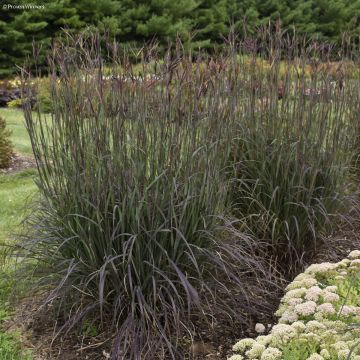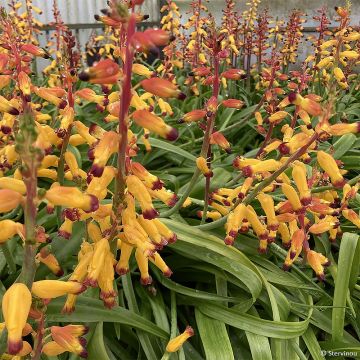

Helictotrichon sempervirens Pendula - Blue oat grass
Helictotrichon sempervirens Pendula - Blue oat grass
Helictotrichon sempervirens Pendula
Blue oat grass
Second order, out of the 3 plants ordered, one seems too small.
Dimitri, 13/04/2022
Special offer!
Receive a €20 voucher for any order over €90 (excluding delivery costs, credit notes, and plastic-free options)!
1- Add your favorite plants to your cart.
2- Once you have reached €90, confirm your order (you can even choose the delivery date!).
3- As soon as your order is shipped, you will receive an email containing your voucher code, valid for 3 months (90 days).
Your voucher is unique and can only be used once, for any order with a minimum value of €20, excluding delivery costs.
Can be combined with other current offers, non-divisible and non-refundable.
Home or relay delivery (depending on size and destination)
Schedule delivery date,
and select date in basket
This plant carries a 12 months recovery warranty
More information
We guarantee the quality of our plants for a full growing cycle, and will replace at our expense any plant that fails to recover under normal climatic and planting conditions.

Would this plant suit my garden?
Set up your Plantfit profile →
Description
Helictotrichon sempervirens 'Pendula', better known as Blue Oat Grass or perennial oat, is an evergreen and perennial grass with an open and elegant habit, remarkable in dry soil. The plant forms a tuft that is both spiky and rounded with long, arching leaves, tinged with silvery blue with metallic reflections. During the summer, numerous straw yellow, trailing and flexible panicles, reminiscent of oats, gracefully rise from the bluish foliage, creating a very successful chromatic association. Hardy, it prefers well-drained soils, sunlight, and withstands summer drought well. Of medium size, it deserves a prominent place in a rockery or a dry garden.
Helictotrichon sempervirens is a grass of the Poaceae family, native to central Europe and southwest Europe. It is a very hardy mountain species that is naturally found on limestone or sandy soils.
The cultivar 'Pendula' is mainly distinguished by a more arched habit and increased floribundance. The plant forms a dense, spreading tuft, 60cm (24in) tall, globular and spiky, composed of long, rigid, prickly leaves, 6mm (1in) wide, with rolled edges, 40 to 60cm (16 to 24in) long, displaying a beautiful steel-blue colour. The flowering plant (from June to August) will easily reach 80cm (32in) to 1.20m (4ft) in height with a spread of 40 to 60cm (16 to 24in). The beige culms, standing well above the foliage, bear spikelets initially bronze green then straw yellow, tinged with purple, gathered in aerial and trailing panicles. Planted in good conditions, this grass shows good drought resistance and excellent hardiness, tolerating negative temperatures down to -20°C (1°F).
From an ornamental point of view, 'Pendula' blue oat grass is remarkable for its vigour, graceful habit, and the very blue colour of its leaves. Helictotrichon sempervirens 'Pendula' is the ideal grass for gravel gardens, rockeries, or well-exposed slopes because it doesn't appreciate wet regions and soils. This very graphic plant adds dimension to sunny flower beds and rockeries, when cleverly placed at the edge or in corners. You can also plant it en masse in a large garden to create an attractive ground cover all year round. It pairs well with the silver foliage of certain wormwoods and bear's ears, placed on a bed of white pebbles. A successful combination can also be achieved with the blue flowers of globe thistles, perennial flax, or love-in-a-mist. The delicate white flowers of Gauras and Cosmos enhance its beauty. Planted in a large container, it will elegantly structure the terrace decor, just like a bush.
Report an error about the product description
Helictotrichon sempervirens Pendula - Blue oat grass in pictures




Flowering
Foliage
Plant habit
Botanical data
Helictotrichon
sempervirens
Pendula
Poaceae
Blue oat grass
Central Europe
Other Ornemental grasses A to Z
View all →Planting and care
Helictotrichon sempervirens 'Pendula' dislikes heavy and damp soils. It prefers light and rich soils, even sandy, rocky and limestone ones, and always very well-drained. A very sunny exposure is obligatory. Offer it preferably a rather poor to moderately fertile soil (to intensify the blue colour of the foliage), preferably limestone or neutral.
Planting period
Intended location
Care
Planting & care advice
-
, onOrder confirmed
Reply from on Promesse de fleurs
Similar products
Haven't found what you were looking for?
Hardiness is the lowest winter temperature a plant can endure without suffering serious damage or even dying. However, hardiness is affected by location (a sheltered area, such as a patio), protection (winter cover) and soil type (hardiness is improved by well-drained soil).

Photo Sharing Terms & Conditions
In order to encourage gardeners to interact and share their experiences, Promesse de fleurs offers various media enabling content to be uploaded onto its Site - in particular via the ‘Photo sharing’ module.
The User agrees to refrain from:
- Posting any content that is illegal, prejudicial, insulting, racist, inciteful to hatred, revisionist, contrary to public decency, that infringes on privacy or on the privacy rights of third parties, in particular the publicity rights of persons and goods, intellectual property rights, or the right to privacy.
- Submitting content on behalf of a third party;
- Impersonate the identity of a third party and/or publish any personal information about a third party;
In general, the User undertakes to refrain from any unethical behaviour.
All Content (in particular text, comments, files, images, photos, videos, creative works, etc.), which may be subject to property or intellectual property rights, image or other private rights, shall remain the property of the User, subject to the limited rights granted by the terms of the licence granted by Promesse de fleurs as stated below. Users are at liberty to publish or not to publish such Content on the Site, notably via the ‘Photo Sharing’ facility, and accept that this Content shall be made public and freely accessible, notably on the Internet.
Users further acknowledge, undertake to have ,and guarantee that they hold all necessary rights and permissions to publish such material on the Site, in particular with regard to the legislation in force pertaining to any privacy, property, intellectual property, image, or contractual rights, or rights of any other nature. By publishing such Content on the Site, Users acknowledge accepting full liability as publishers of the Content within the meaning of the law, and grant Promesse de fleurs, free of charge, an inclusive, worldwide licence for the said Content for the entire duration of its publication, including all reproduction, representation, up/downloading, displaying, performing, transmission, and storage rights.
Users also grant permission for their name to be linked to the Content and accept that this link may not always be made available.
By engaging in posting material, Users consent to their Content becoming automatically accessible on the Internet, in particular on other sites and/or blogs and/or web pages of the Promesse de fleurs site, including in particular social pages and the Promesse de fleurs catalogue.
Users may secure the removal of entrusted content free of charge by issuing a simple request via our contact form.
The flowering period indicated on our website applies to countries and regions located in USDA zone 8 (France, the United Kingdom, Ireland, the Netherlands, etc.)
It will vary according to where you live:
- In zones 9 to 10 (Italy, Spain, Greece, etc.), flowering will occur about 2 to 4 weeks earlier.
- In zones 6 to 7 (Germany, Poland, Slovenia, and lower mountainous regions), flowering will be delayed by 2 to 3 weeks.
- In zone 5 (Central Europe, Scandinavia), blooming will be delayed by 3 to 5 weeks.
In temperate climates, pruning of spring-flowering shrubs (forsythia, spireas, etc.) should be done just after flowering.
Pruning of summer-flowering shrubs (Indian Lilac, Perovskia, etc.) can be done in winter or spring.
In cold regions as well as with frost-sensitive plants, avoid pruning too early when severe frosts may still occur.
The planting period indicated on our website applies to countries and regions located in USDA zone 8 (France, United Kingdom, Ireland, Netherlands).
It will vary according to where you live:
- In Mediterranean zones (Marseille, Madrid, Milan, etc.), autumn and winter are the best planting periods.
- In continental zones (Strasbourg, Munich, Vienna, etc.), delay planting by 2 to 3 weeks in spring and bring it forward by 2 to 4 weeks in autumn.
- In mountainous regions (the Alps, Pyrenees, Carpathians, etc.), it is best to plant in late spring (May-June) or late summer (August-September).
The harvesting period indicated on our website applies to countries and regions in USDA zone 8 (France, England, Ireland, the Netherlands).
In colder areas (Scandinavia, Poland, Austria...) fruit and vegetable harvests are likely to be delayed by 3-4 weeks.
In warmer areas (Italy, Spain, Greece, etc.), harvesting will probably take place earlier, depending on weather conditions.
The sowing periods indicated on our website apply to countries and regions within USDA Zone 8 (France, UK, Ireland, Netherlands).
In colder areas (Scandinavia, Poland, Austria...), delay any outdoor sowing by 3-4 weeks, or sow under glass.
In warmer climes (Italy, Spain, Greece, etc.), bring outdoor sowing forward by a few weeks.



























































